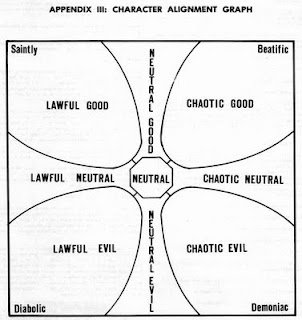To that end, I set out my basic parameters. Alignment is a real, fundamental force in the multiverse. It is tied up in the cosmology of the Great Wheel of Existence. Gods and Ascended beings are fair "strongly aligned" to these planes and their intrinsic alignment forces, but regular mortals don't really have alignment per se.
I really like what Professor Barker has to say in The Tekumel Source Book: "The Gods express not so much human objectives as their own viewpoints of existence and the eventual destiny of the cosmos."
In other words, alignment isn't about human ethics, but instead about teams in a cosmic game. You choose a god of a particular alignment, you choose a side--but you get to choose how fervently you support your team. This allows a human world with shades of gray rather than absolutes, which not only looks more like the "real world," but more importantly looks like the worlds of Conan, Fafhrd & Gray Mouser, Kane, and most of the other pulp fantasy icons. This also explains how, for the most part, human societies can exist with a mixture of servants of different alignments side by side without constant holy war.
That all works, but AD&D has some beings which are more pro- or anti-social that others. Demons and devils are mostly antagonists for players--even evil ones. I think that the alignments are tangentially related to certain human moral or ethical concerns, even if that's not their primary focus. My conception of what those concerns are was influenced by a comment on a blog I read a couple of years ago, which I haven't been able to relocate, and so I can't properly credit. The unknown commenter mentioned the Moral Foundations Theory as a good model for what alignments "mean"--but didn't elaborate. A visit to Jonathan Haidt's website on Moral Foundations Theory made me think the commenter had a point.
In brief, the theory breaks human morality into five universal themes/concerns (and they're looking at a sixth). These are:
- Harm/Care - underlies virtues of kindness, and nuturance.
- Fairness/Reciprocity - underlies the virtue of justice, among others.
- Ingroup/Loyalty - underlies patriotism, among other virtues.
- Authority/Respect - underlies deference to authority, and respect for tradition.
- Purity/Sanctity - underlies the ideals of avoidance of physical and mental contamination.
So, in no doubt an application of the theory its proponents never though of, these traits can be mapped to the orthogonal dualities of the AD&D alignment system. Good is concerned with Harm/Care, Fairness/Reciprocity, and Ingroup/Loyalty, while Evil is cruel, injustice, and sociopathic. Law is concerned with Authority/Respect and Purity/Sanctity, while Chaos is anti-authority, and profane. Neutral on either axis would be "no opinion" on the issue in question.
Not that these values are what the alignments "mean" or completely represent in a cosmic sense, but like the story of the blind men and the elephant, these are the features humans can recognize and grasp.
So that's alignment in my current campaign. For the players it doesn't much influence things, as it isn't something characters "have." But it underlies how the world works, and it's given me some interesting perspectives on the natures of supernatural beings that do have alignments by allowing me to look at them in terms of the five foundations.










